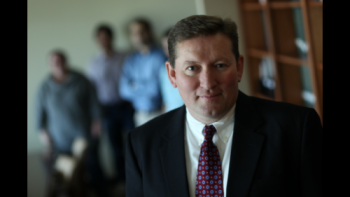Baylor Scientists Aim to Design Safer Chemicals for Humans and Environment with Multimillion Dollar Grant
WACO, Texas — April 10, 2014
 Bryan W. Brooks, Ph.D., professor of environmental science and biomedical studies in Baylor University’s College of Arts & Sciences and director of the environmental science graduate program and the environmental health science program, will lead the research core on a four-year, $4.4 million project aimed at designing chemicals and materials that are less toxic to humans and the environment.
Bryan W. Brooks, Ph.D., professor of environmental science and biomedical studies in Baylor University’s College of Arts & Sciences and director of the environmental science graduate program and the environmental health science program, will lead the research core on a four-year, $4.4 million project aimed at designing chemicals and materials that are less toxic to humans and the environment.
Brooks, his students, staff and Spencer Williams, Ph.D., research assistant professor in the Center for Reservoir and Aquatic Systems Research (CRASR) at Baylor, and researchers from Yale University, George Washington University and the University of Washington will collaborate on the four-year project. The National Science Foundation and Environmental Protection Agency funded the project with Brooks being awarded more than $997,000 for research associated with the project.
The four-university interdisciplinary team or the Molecular Design Research Network (MoDRN) will develop tools that help molecule designers predict toxic properties of new and existing chemicals and modify their designs to reduce risks while maintaining their effectiveness.
“One goal of this project is to leverage lessons learned from designing safer pharmaceuticals to identify attributes of industrial chemicals that could be designed to also be safer for public health and the environment,” Brooks said.
The project, which is currently underway, is divided into three parts: research, outreach and education. The research component will focus on the creation of computer models and a public database that will help in the design of new chemicals to assess whether a molecule is likely to cause toxicity. Education and outreach efforts, which are coordinated at Baylor by Melissa Mullins, environmental educator in CRASR, will engage high school students, undergraduates, teachers and practitioners.
“One of the reasons we are excited about this project is that in the history of environmental science and environmental health we have largely responded to challenges. For example, we typically react to understand whether contaminants found in the environment will adversely affect human health and ecosystems,” Brooks said. “This project represents a conceptually different approach because we aim to be more proactive by identifying inherent properties of chemicals that result in health hazards. An understanding of these properties promises to support next generation synthesis of organic chemicals that are less toxic.”
The toxicology research portion will be conducted mostly at Baylor and the University of Washington. The project has national and international implications and has the promise to result in more sustainable practice for the creation of new chemicals, Brooks said.
“This is an excellent opportunity for Baylor students and faculty to collaborate within a truly interdisciplinary network of colleagues with complementary expertise in an area that has the potential to advance important goals of sustainability,” Brooks said.
Brooks, who is currently a Fulbright Canada Visiting Research Chair in Water and the Environment at the University of Lethbridge in Canada, is recognized as an international expert on environmental contaminants and water quality issues in urban regions. His research team focuses efforts on water quality and water reuse, comparative toxicology and pharmacology, sustainable molecular design, developing approaches to define contaminant risks and the ecology and toxicology of harmful algae blooms.
He has authored more than 100 book chapters and articles in scholarly journals and most recently published “Human Pharmaceuticals in the Environment: Current and Future Perspectives” in 2012. He serves as associate editor of Environmental Toxicology and Chemistry and Integrated Environmental Assessment and Management.








